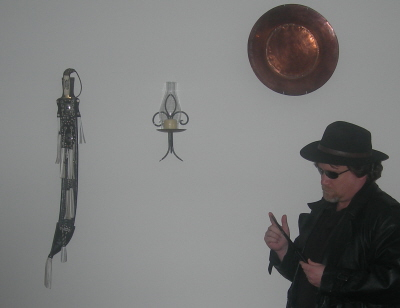|
About This Author
Come closer.
|
Complex Numbers
Complex Numbers
A complex number is expressed in the standard form a + bi, where a and b are real numbers and i is defined by i^2 = -1 (that is, i is the square root of -1). For example, 3 + 2i is a complex number.
The bi term is often referred to as an imaginary number (though this may be misleading, as it is no more "imaginary" than the symbolic abstractions we know as the "real" numbers). Thus, every complex number has a real part, a, and an imaginary part, bi.
Complex numbers are often represented on a graph known as the "complex plane," where the horizontal axis represents the infinity of real numbers, and the vertical axis represents the infinity of imaginary numbers. Thus, each complex number has a unique representation on the complex plane: some closer to real; others, more imaginary. If a = b, the number is equal parts real and imaginary.
Very simple transformations applied to numbers in the complex plane can lead to fractal structures of enormous intricacy and astonishing beauty.
January 23, 2023 at 12:01am January 23, 2023 at 12:01am
| |
Space is cool. And sometimes, we can learn things about it while never leaving our planet.
First, confession time: I'm always confused by ton, metric ton, short ton, shit ton, etc. A metric ton is apparently 1000kg, which is the same thing as 1 megagram, which is a separate thing from a megaton, and is a unit of mass, not weight, though on the surface of the Earth, mass units are often used as weight units. See why I get confused?
If you're from the US, 15 metric tons is about 33,000 pounds, which for comparison is about the weight of a half-full ready-mix concrete truck. If you're from the UK, it's about 2,360 stone. If you're from anywhere else, it's 15 metric tons.
Scientists have identified two minerals never before seen on Earth in a meteorite weighing 15.2 metric tons (33,510 pounds).
I'm going to go off on another tangent here.
As you know, I'm a big fan of science fiction. Love the stuff. But sometimes it's more fiction than science, like when someone finds an alien artifact and exclaims "This contains elements not found on the periodic table!" or some shit like that.
Well, no. You're going to have to do better than that. The periodic table is full; that is, there are no gaps for new, alien elements. Each entry on the table represents a number of protons in a nucleus. You don't get to have half a proton. The only other possibility is elements beyond the end of the current established table, ones that we'd need a particle accelerator to create. While those might exist, their nuclei are so large and unstable that they would have a half-life measured in picoseconds. There is speculation about an "island of stability" of heavier elements with longer half-lives, but even there, they're thinking half-lives of, perhaps, days—still too short to survive an interstellar journey.
Sure, it's speculation, so you can pretend there's a superheavy element that's completely stable, but I want to see that in the story, not just "new element!"
Unobtainium, my ass. No, I'm still not going to watch Avatar:The Last Waterbender.
Okay, so there is one other possibility I can think of for "elements not found on the periodic table": exotic matter. Like, I dunno, maybe atom-equivalents made up of nuclei consisting of particles containing strange and charm quarks, with electrons replaced by tau particles. Speculative stuff like that. I've already banged on long enough, so I'll just say that if you mean exotic matter, freakin' say "exotic matter," and don't pretend that your "unknown element" is a collection of ordinary protons, neutrons, and electrons.
All of which is to say that I can easily see someone reading this CNN story and thinking "two minerals never before seen on Earth" and immediately leaping to "exotic matter." No. A mineral is a particular arrangement of a known element or known elements, like quartz (silicon and oxygen), corundum (aluminum and oxygen), pyrite (iron and sulfur), diamond (carbon), graphite (carbon), or chaoite (carbon).
What this article is saying is that these unusual arrangements of perfectly ordinary elements don't get formed naturally on Earth (or at least not in sufficient quantity to have been discovered). They have, as the article notes, been created in laboratories.
One mineral’s name — elaliite — derives from the space object itself, which is called the “El Ali” meteorite since it was found near the town of El Ali in central Somalia.
Herd named the second one elkinstantonite after Lindy Elkins-Tanton, vice president of Arizona State University’s Interplanetary Initiative.
Well, I suppose that's one way to try to get someone to sleep with you.
“Whenever you find a new mineral, it means that the actual geological conditions, the chemistry of the rock, was different than what’s been found before,” Herd said. “That’s what makes this exciting: In this particular meteorite you have two officially described minerals that are new to science.”
Technically, they weren't formed under geological conditions. That would imply that they were indeed made on Earth. If they were made on the Moon, they'd be called selenological conditions; on Mars, areological conditions. I don't know what they're called if they're from a random asteroid, and I can't be arsteroided to find out.
Also technically, the minerals aren't new to science; just the naturally-occurring forms are.
Incidentally, none of my above ranting is meant to downplay the coolness of finding new minerals from space. It's a potential glimpse into low-gravity mineral formation, and possibly even the early conditions of the solar system, and that's great for science. (And no, it's not aliens.)
Two-thirds of the way down the page, they finally get around to describing—sort of—the composition of the minerals:
Both new minerals are phosphates of iron, Tschauner said. A phosphate is a salt or ester of a phosphoric acid.
I'm sure that clears everything right up for those of you without chemistry backgrounds. Though you're probably familiar enough with phosphoric acid. It's one of the primary non-water ingredients in Coke, which I happen to be drinking right now (look, even I can't drink beer all the time).
“Phosphates in iron meteorites are secondary products: They form through oxidation of phosphides … which are rare primary components of iron meteorites,” he said via email. “Hence, the two new phosphates tell us about oxidation processes that occurred in the meteorite material. It remains to be seen if the oxidation occurred in space or on Earth, after the fall, but as far as I know, many of these meteorite phosphates formed in space. In either case, water is probably the reactant that caused the oxidation.”
Even if the oxidation occurred on Earth, it's still interesting because the basic materials were there to be oxidized. But there's water in space (that's how it got here in the first place), mostly in the form of ice, but it's not outrageous to imagine a body on an eccentric orbit whose internal ice melts periodically, allowing for liquid water to do its reaction thing.
Comets, for example, contain significant amounts of water. But from what I understand, their formation is distinct from that of iron-rich asteroids. The point is, though, that water's out there.
Anyway, questionable science reporting aside, I thought this was cool enough to share—but more importantly, to nitpick. |
© Copyright 2025 Robert Waltz (UN: cathartes02 at Writing.Com). All rights reserved.
Robert Waltz has granted InkSpot.Com, its affiliates and its syndicates non-exclusive rights to display this work.
|

